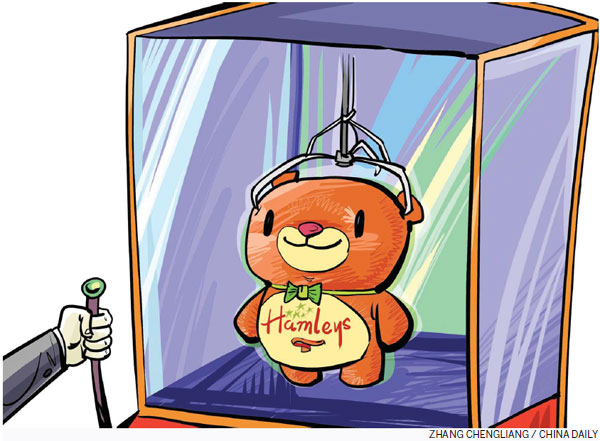Toy story with a happy Chinese ending
C.banner takes over prestigious Hamleys brand and, in the process, looks to build its own
It is clearly apparent that President Xi Jinping's recent visit to the United Kingdom, which is estimated to have generated business deals worth an eventual 40 billion pounds ($60 million; 56 million euros), has empowered Chinese companies with increased self-belief and determination to go global.
In late October, Chinese footwear company C.banner International Holdings agreed to take over Hamleys - the UK's iconic London toy retailer - for 100 million pounds.

It has been reported that C.banner, a Hong Kong-listed Chinese private enterprise, has declared itself as a strategic partner of China's Sanpower Group in this venture. It also appears likely that the Sanpower involvement will be highly influential, given its acquisition only last year of the UK retailer House of Fraser.
The latest Chinese takeover involves the acquisition of a premium, even prestigious, and international brand. But even more significant is perhaps the partnership between C.banner and Sanpower, without which the deal may not have been struck.
This is a positive sign for the further internationalization of Chinese industry. Few companies can go it alone on the road to global growth and, therefore, successful strategy is as much about selecting and working with the most suitable partner as it is about effective brand building. C.banner and Sanpower appear to be compatible business partners.
Hamleys' global fame has a lot to do with its rich heritage, which stretches back 255 years. But it is perhaps Hamleys' 134-year-old flagship store on London's Regent Street that is the jewel in the now Chinese retail industry's crown.
Understandably, the Hamleys brand is most likely to remain pretty much as it is, with a brand image steeped in historic value. William Hamley first launched the toy shop as a kind of Noah's Ark in 1760. Originally stocking little more than tin soldiers, wooden horses and rag dolls, the Regent Street flagship store now boasts more than 50,000 toys over seven floors. An estimated five million visitors now consider the store one of London's major tourist attractions.
C.banner's ambitious takeover not only provides an immediate presence in one of the most fashionable London locations, it also opens up market opportunities across Europe and beyond.
Despite the association with the flagship London store, Hamleys has expanded geographically on an ever-increasing scale in recent years.
Hamleys can now be considered almost a worldwide retail chain with 10 other outlets in the UK and almost 50 franchises worldwide.
The Chinese footwear brand now effectively has a UK retail market presence through Hamleys' stores in major cities such as Cardiff, Glasgow, Manchester, Sheffield and York. Hamleys also boasts a presence at the three London airports.
But perhaps most exciting about C.banner's acquisition is the market presence it now has internationally.
In recent years, Hamleys has expanded its footprint globally and has a presence in Denmark, Ireland, Sweden, Norway, the United Arab Emirates, Jordan, Saudi Arabia, India, the Philippines and South Africa.
Clearly, the new Chinese owner has followed Hamleys' international brand expansion closely and sees this acquisition as a key part of its own ambitious global plans.
President Xi has long called for Chinese companies to move up the value chain toward a high-investment, high-technology and high-quality premium brand-oriented culture. C.Banner has done just that.
It should be no surprise at all to see the launch of a massive Hamleys store in one of the most attractive locations of one or more of China's top cities. But perhaps what would cause some surprise, even consternation perhaps, is the deployment of a two-tier brand strategy, which in some way publicly presents both the Hamleys and C.banner brands together.
Two-tier brand strategies usually begin with the corporate brand name dominating the brand name partnership (source branding) and the often newer product sub-brand name assuming a subservient role. But over time the fresher sub-brand name often rises in importance and the corporate name fades in the consumers' mind (endorsement branding). The relationship between Apple and iPhone is perhaps a good example of this, where Apple still plays an important role but iPhone is perhaps the more dominant name among consumers.
C.banner now has a perfect opportunity to pursue two-tier branding to raise the brand awareness and build the brand image of its corporate name. Such a two-tier brand strategy should come under serious consideration while news of the Hamleys takeover is so fresh and global.
Of course, the Hamleys brand name should remain firmly the dominant partner in any two-tier branding strategy.
The public display on the C.banner name, albeit far smaller than the Hamleys name, will signify real determination by the Chinese company to build a Chinese global brand and will set a perfect platform for C.banner to launch a vast array of related product brands internationally.
Product branding where the C.banner corporate name is largely hidden could create suspicion and confusion, even more reason for the Chinese owners of Hamleys to put in place as soon as possible a public display of the two names. Such a bold and proud display will build awareness of the Chinese company's name, but more tellingly, attachment of the two names should begin to build a favorable corporate brand name association based on the trust and heritage of the Hamleys name.
In short, the 100 million pounds spent is a bold move, but a far bolder and even more important move is the public display of the C.banner name alongside the Hamleys name worldwide. Development of the C.banner brand and image is as important as the maintenance and leverage of the Hamleys' brand.
The author is a visiting professor at the University of International Business and Economics in Beijing and a senior lecturer on marketing at Southampton Solent University's School of Business. The views do not necessarily reflect those of China Daily.


















